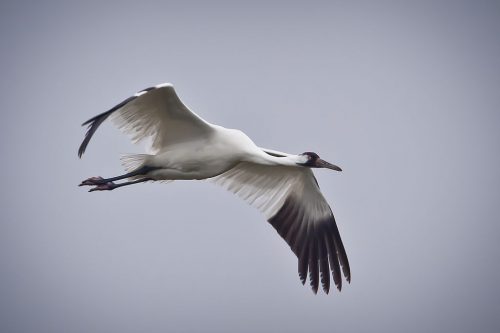
BY JUDY CARMACK BROSS
Many years ago, only twenty of the funniest looking birds around returned each winter to the Gulf Coast wetlands of Texas near Rockport. These five-foot-tall white whooping cranes from Canada were on the brink of extinction due to unregulated hunting and reduction of their habitats. Rockport—and the Aransas National Wildlife Refuge where they nested—were names known principally to ornithologists and Houstonians who built second homes along its sparkling beaches.
Photographs of horrific Harvey have changed all of that. Rockport, of course, felt the first unbelievable destruction of this tropical storm. The scenes of suffering are unbearable for those of us who feel helpless and far removed.
Somehow, the survival of the whooping cranes brings hope to Texans like me this week. While they can often appear to be walking on stilts and their honks sound hilarious, when whooping cranes catch the wind in flight they soar with rare beauty.
One of my parent’s proudest accomplishments was helping to save the whooping cranes. My father, George Carmack, was the editor of the crusading Houston Press, a champion of lost causes for the public good. My mother, Bonnie Carmack, who had been a reporter before she married my father, served as his co-pilot in many adventures, researching and photographing.
The desperate fate of the whooping crane became a challenge to both of them, and we spent many weekends during my childhood in Rockport working on the story of the cranes. I do think my parents started the conservation efforts that saved the cranes through editorial campaigns in the Houston Press urging for expansion of the wetlands and to stop the hunting of the cranes and instead start tracking their migrations.
Today, there are 603 whooping cranes, many of which return each winter to Rockport from the Wood Buffalo National Park in northeast Alberta. Their antics provide delight for the large numbers of tourists and birdwatchers who come with the regularity of the cranes.
To attract mates, whooping cranes jump up and down, flap their wings (that stretch to over seven feet long), and then loudly announce their intentions. They like lots of space, sometimes each family marking off a mile of mudflats as their personal territory.
Many people know of whooping cranes because of an airplane that created a new migrating flock, traveling from Wisconsin to Florida and back each year. The International Whooping Crane Recovery Team used an ultra-light aircraft as a teaching tool to show young cranes how to migrate without the assistance of adult birds—truly a mother ship.
The only whooping cranes living in the wild today are the ones near Rockport. Tourists and residents come to see them on boats that ferry visitors to their habitats.
Beautiful homes line these causeways around Rockport, and restaurants feature some of the best shrimp around. Harvey hit Rockport first and with full force.
A Los Angeles Times reporter who visited the area a few days ago said that homes resemble pancakes, that everything that is still standing now leans. Crazy Mary’s, the shrimp restaurant beloved by everyone, has distributed 2,000 meals of comfort food from an outdoor station. The Rowdy Maui gift shop, one of the few buildings still standing, has a sign out front saying “Rockport Strong.” The whooping cranes are still in Canada, but one resident is feeding Cheetos to a sea gull with a broken wing.
The whooping cranes will return to Rockport in November, bringing their story of hope. In the meantime, Rockport residents, known for their resilience and spirit, are working together to rebuild the community—one person told an old man whom he fed that it was not a hand out, but a hand up.
I imagine how my father would have found a way to swim, boat, or otherwise find his way to the Houston Press to tell the story of what is happening in Houston right now because outstanding journalists really do feel a higher call.
Bonnie and George would be in Rockport, praising its residents for their courage, waiting for the cranes—always our symbol of hope—to arrive.










